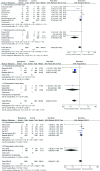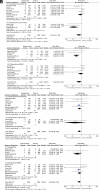Efficacy of Topical Epinephrine in Preventing Post-Endoscopic Retrograde Cholangiopancreatography Pancreatitis: A Meta-analysis
- PMID: 39344664
- PMCID: PMC11391239
- DOI: 10.5152/tjg.2024.23386
Efficacy of Topical Epinephrine in Preventing Post-Endoscopic Retrograde Cholangiopancreatography Pancreatitis: A Meta-analysis
Abstract
Post-endoscopic retrograde cholangiopancreatography (ERCP) pancreatitis (PEP) is the most common complication of ERCP. As the clinical effectiveness of topical epinephrine in preventing PEP is elusive, this work attempts to assess its impact on PEP prevention. The databases Embase, Web of Science, PubMed, and Cochrane Library were searched for randomized controlled trials (RCTs) and retrospective cohort studies (RCSs) on topical epinephrine in PEP prevention (data cutoff, November 2022). This study included a total of 10 research articles, involving 5683 patients, comprising 7 RCTs and 3 RCSs. The results of the meta-analysis indicated that epinephrine had no significant effect on preventing PEP or improving its severity. The meta-analysis results of RCTs subgroup revealed no significant difference in the incidence of PEP between patients receiving epinephrine treatment [alone/in combination with nonsteroidal anti-inflammatory drugs (NSAIDs)] vs. without epinephrine treatment (control group) (P = .23). However, patients treated with epinephrine alone experience a lower incidence of PEP compared to the control group (risk ratio [RR] = 0.28, 95% CI = 0.14-0.56, P = .0004). The treatment with epinephrine+NSAIDs vs. NSAIDs showed no significant difference (P = .95). The meta-analysis results of RCSs subgroup demonstrated a significant reduction in the incidence of PEP with the epinephrine+NSAIDs vs. NSAIDs (P < .05). Regarding the severity of PEP [mild, and moderate to severe (M-S)] in the RCT subgroup, the incidence of PEP was not reduced with epinephrine treatment (alone/in combination with NSAIDs) vs. control group. In the RCS subgroup, receiving epinephrine (alone/in combination with NSAIDs) reduced the incidence of mild PEP, while it had no effect on the incidence of M-S PEP. Epinephrine was not significantly effective in preventing PEP and improving its severity. The combined use of NSAIDs and epinephrine as a possible preventive measure requires further investigation into its efficacy.
Conflict of interest statement
Figures




Similar articles
-
Nitroglycerin combined with NSAIDs for prevention of post-ERCP pancreatitis: A meta-analysis of prospective, randomized, controlled trials.Medicine (Baltimore). 2024 Jul 5;103(27):e38764. doi: 10.1097/MD.0000000000038764. Medicine (Baltimore). 2024. PMID: 38968498 Free PMC article.
-
Efficacy of Combined Management with Nonsteroidal Anti-inflammatory Drugs for Prevention of Pancreatitis After Endoscopic Retrograde Cholangiography: a Bayesian Network Meta-analysis.J Gastrointest Surg. 2022 Sep;26(9):1982-1997. doi: 10.1007/s11605-022-05352-7. Epub 2022 Jun 9. J Gastrointest Surg. 2022. PMID: 35680777 Review.
-
Effectiveness of nonsteroidal anti-inflammatory drugs in prevention of post-ERCP pancreatitis: a meta-analysis.World J Gastroenterol. 2014 Sep 14;20(34):12322-9. doi: 10.3748/wjg.v20.i34.12322. World J Gastroenterol. 2014. PMID: 25232268 Free PMC article. Review.
-
What is impact of nonsteroidal anti-inflammatory drugs in the prevention of post-endoscopic retrograde cholangiopancreatography pancreatitis: a meta-analysis of randomized controlled trials.BMC Gastroenterol. 2018 Jul 4;18(1):106. doi: 10.1186/s12876-018-0837-4. BMC Gastroenterol. 2018. PMID: 29973142 Free PMC article. Review.
-
Rectal nonsteroidal anti-inflammatory drugs administration is effective for the prevention of post-ERCP pancreatitis: An updated meta-analysis of randomized controlled trials.Pancreatology. 2017 Sep-Oct;17(5):681-688. doi: 10.1016/j.pan.2017.07.008. Epub 2017 Jul 17. Pancreatology. 2017. PMID: 28734720
Cited by
-
Endoscopic Retrograde Cholangiopancreatography in Pediatric Population: A Decade-Long Experience from 2 Tertiary Centers.Turk J Gastroenterol. 2025 Jan 13;36(5):321-327. doi: 10.5152/tjg.2025.24462. Turk J Gastroenterol. 2025. PMID: 39840842 Free PMC article.
References
-
- Akbar A, Abu Dayyeh BK, Baron TH, Wang Z, Altayar O, Murad MH. Rectal nonsteroidal anti-inflammatory drugs are superior to pancreatic duct stents in preventing pancreatitis after endoscopic retrograde cholangiopancreatography: a network meta-analysis. Clin Gastroenterol Hepatol. 2013;11(7):778 783. ( 10.1016/j.cgh.2012.12.043) - DOI - PubMed
Publication types
MeSH terms
Substances
LinkOut - more resources
Full Text Sources
Medical
Research Materials
Miscellaneous
